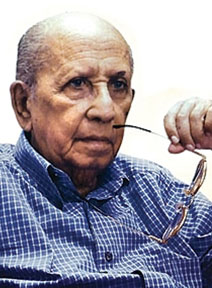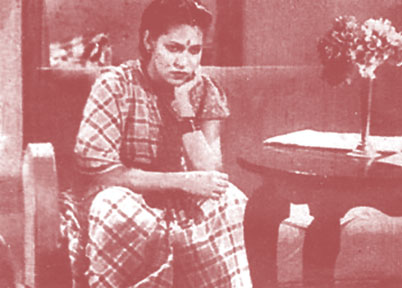Sri Lankan cinema +66
By Kalakeerthi Edwin Ariyadasa
"The violent effort, which the Sinhala film-producers thought it
necessary to make, in order to hang a handful of characters on some
trivial peg of a plot, has given us a film-fare, strongly reminiscent of
the bioscopic and silent beginnings of the cinema.
 |
|
Dr. Lester James Peries |
... If the Sinhala film were to develop at the expense of Sinhala
drama - as it has done hitherto, the people to whom art and culture
matter will not find it too happy a prospect... But, it is quite
essential that the Sinhala film-makers who have discarded the stage for
the screen, should remember that the film requires a technique of
handling different from the state..."
Edwin Ariyadasa
(From an article titled "The Sinhalese Film - A wife and Five
Puppets" contributed to the Observer Pictorial - 1950).
The 66th anniversary of Sinhala cinema dawned, illumined by the
ethereal glow of the long-awaited Sinhala film-epic "Sri Siddhartha
Gautama" - the cinematic narration of the sacred life of Siddhartha
Gautama. This exquisite film-event, holds an unprecedented promise for
the new era of Sri Lankan cinema.
In historical hindsight, we note that the first Sinhala film, that
ushered in the tradition of Sri Lankan cinema, was, strangely enough
"Broken Promise," released on January 21, 1947.
The processes that eventually led to the presentation of "Broken
Promise", as the first-ever Sinhala film, were determined not by
creative, artistic or cultural factors but solely by economic and
financial considerations.
Back then, the world was still in the throes of the aftermath of a
global war. In Sri Lanka (Ceylon then) near-universal employment and
war-time inflation ensured a steady flow of cash, bringing in its wake a
euphoric sense of sudden affluence. The ever-present threat of death and
destruction, inevitable in times of war, though muted to an undertone,
unleashed a frenzied indulgence in sensual pleasures.
Entertainment
The most widespread form of entertainment available to the people,
was the legitimate theatre. In the new centres of human settlement,
called into existence, through the exigencies of the war-effort, the
itinerant theatrical companies, received an adoration that seemed to
verge on the religious. The Sinhala actors and actresses, who became
mass-idols of the day, could not cope adequately with the
ever-burgeoning demand for their plays.
In the nature of things, the live presence of a given actor or
actress could happen only at one place at one time. In such a context,
if the theatre companies were keen to rake in the available shekels in
larger quantities, they had to devise a method of multiplying the
appearance of these players, so that, they could perform simultaneously
at several centres.
The crucial question was, how could this 'miracle' be worked out?
Cinema, of course, held the key to the solution of this problem. The
proposition was simple: convert the stage-play into its photographed
version - and, you get a simultaneous island-wide audience for your
"play". This exactly was the thinking that resulted in the birth of
Sinhala cinema.
At the height of this preoccupation with the cinematographed stage
play-that is approximately during the latter half of 1946 - Sri Lanka
did not have even a war on while movie camera - not to say anything
about studios or other facilities for the product of films locally.
An artistic and economic pilgrimage had to be made to South India -
as that was the film-making location closest to us. And, that was how,
on January 21, 1947, "Broken Promise" (Director:B.A.W. Jayamanne) came
to be released as the first-ever Sinhala film. While maknig history that
way, it became the first, in a series of Sinhala films of South Indian
origin.
Technical facilities
The historical necessity that compelled the pioneering Sinhala
film-makers to seek South Indian technical facilities and directorial
talents, imparted a marked theatrical bias to the first Sinhala film.
Writing in the Observer Pictorial for 1950, under the title "The
Sinhala Film - A wife and five puppets" I made my observations of the
Sinhala cinema, which was only three years old then. (I must confess
though, that the title has a slight trace of cynicism). There I said the
following (among other things).
"Seeing the camera utilised merely as an instrument to record events
that take place in chronological order, would have been immensely
satisfying to the film-goers of the early days of cinema. But today
(1950) when cinema audiences get an opportunity of seeing the power the
film camera is capable of the only thing that compels one to see these
films, is the fact that they are in Sinhalese."
Formula films
It is to the credit of the Sinhala film-goers that he grew weary of
this kind of film-fare, within the first decade itself. The people
discovered before long, that what was offered to them was neither
Sinhala nor cinema, in the real sense.
The individual who endowed a new incarnation on the formula - ridden
Sinhala cinema, is of course, cinema-savant Lester James Peries. By
common consent LJP is the supreme hero of the 66 years of Sinhala film
history.
 |
|
A scene from Kadawunu
Poronduwa |
At a celebration, organised by the National Film Corporation, great
Lester James Peries, was especially felicitated, as the personality of
the 66 years of Sinhala cinema.
Lester James Peries introduced a professional elegance to the
business of film-making in Sri Lanka, going counter to the "creative
shabbiness" that generally prevailed in that field, prior to the
appearance of his Rekawa (Line of Destiny, 1956).
Rekawa was shot almost entirely on location in Sri Lanka, at a time
when outdoor shooting was a rare phenomenon both in South India and Sri
Lanka. The effort to instil the 'Sinhala feel and the cinematic
discipline' into Sri Lankan cinema was initiated by LJP, when he based
his films firmly on themes deeply rooted in our native soil.
Enthusiasm
In the enthusiasm to shower praise on LJP, as a pioneer in the
indigenous tradition of film-making, many tend to overlook a yet another
profound contribution he made to Sri Lanka's cinema scenery.
In the off-quoted phrase - T.S. Eliot, revolutionary poet and
aesthetic guru - declared that the purpose of criticism, is the
"Elucidation of works of art, and the correction of taste."
Lester James Peries, waged a valiant battle - single-handedly at
first - to correct Lankan film-goers. LJP, weaned the Sri Lankan film
and engendered in them a taste for quality film-making, that probes the
deeper larger of human existence, utilising cinema-art with a telling
deptness.
Lester elevated Sri Lankan cinema to global heights. This resulted in
the pronouncing of Lester James Peries' name with the same hushed tones,
as those of Akira Kurasawa, Satyajith Ray and Ingmar Bergman.
Establishment
In the realm of Sri Lankan cinema, Lester James Peries is decidedly
the unassailed "Establishment". In any field, people respond to an
establishment in one of two ways.
They may resent it, revolt against it or denounce it. Or else they
would adore it, admire it, esteem it or emulate it.
Whatever may be the attitude adopted, a well-entrenched establishment
generates the dynamism that ensures progress. No worthwhile discourse on
cinema is possible, without Lester's name assuming centre - stage in
that kind of colloquy.
Lester James Peries' far reaching influence, began to be felt
especially after his Gamperaliya (The Changing Village).
Released in the mid-sixties this symbolised the climactic meeting so
far in the history of Sri Lankan cinema, between an exclusively Sinhala
theme and an essentially cinematic interpretation. Gamperaliya assumes a
special importance for several other reasons as well.
Award
In 1965, it was the "Golden Peacock" from India. This award was a
tremendous ego-boost for Sri Lanka's film-psyche. From then on, Sinhala
film began to acquire a prestige it did not enjoy earlier.
People no longer felt that they needed to be apologetic about the
Sinhala film, like an urban sophisticate about the coarse ways of his
country cousin.
Gamperaliya established Lester James Peries, with a distinct
"imprint" of his own. He could no longer fail but only fluctuate.
In his 57-year long film career his sustained effort has been to
build a cinematic conduit to one heart of Sri Lankan culture.
Many personalities associated with the 66 year-long Sri Lankan cinema
history, either as directors, actors, actress and technicians have
displayed widely recognised talents.
Progress
In the recent years however, the progress has been uneven both in
quality and quantity.
The present chairman is committed to wisher in a new era for Inhalant
cinema, privilising the construction of state-of-the-art cinema
theatres.
It is essential to build an indigenous cinema culture, that will
uphold our cinema works, giving them the same prestige as what we give
to our sacred edifices, our hydro-culture, our art now literature and
our gentle style of existence.
Building a cinema culture is not equivalent to the creation of
film-bufts and gossipy other about men and women of cinema.
It is a much more profound phenomenon, that will lead to the
emergence of generation possessing high-well-informed deference for the
indigenous film icons. This needs an extensive discourse.
Such a fruitful discourse should be initiated as an outcome of our
celebration of 66 years of Sinhala cinema. |



